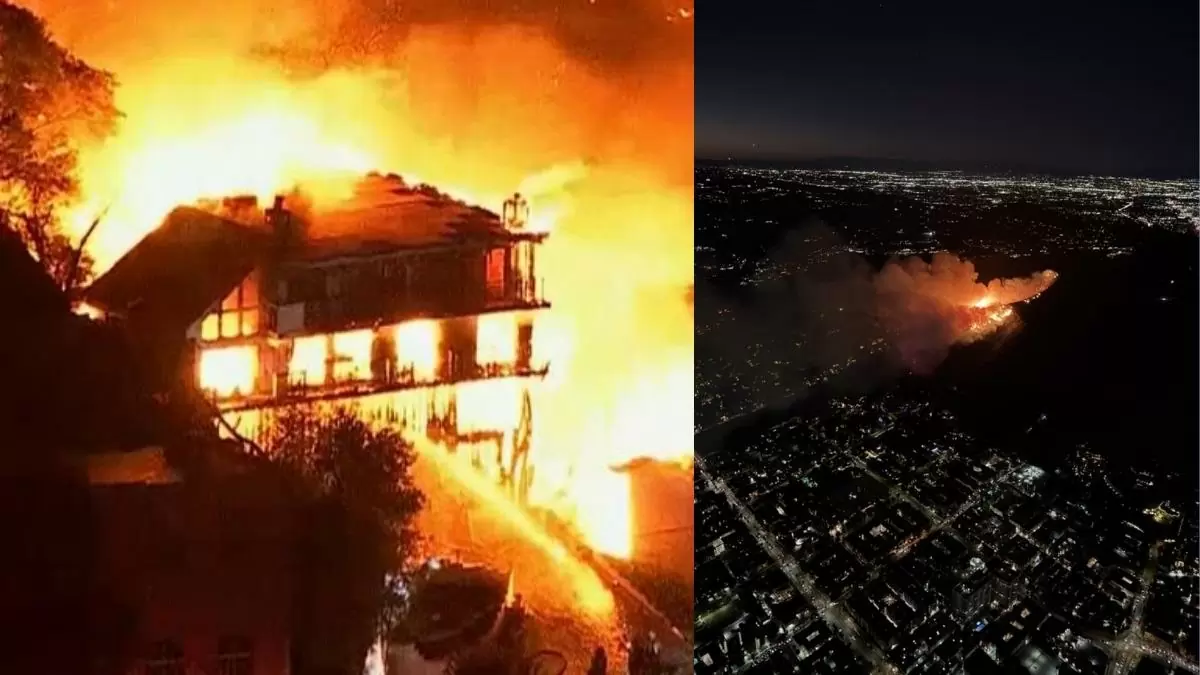Homes Destroyed as Fires Erupt in Hollywood, Studio City
Los Angeles residents are once again on edge as weary firefighters combat fresh fires that erupted late Wednesday night in Studio City and the Hollywood Hills. With several homes already engulfed in flames, the situation has escalated into yet another urgent battle against nature.
Fires Ignite in Studio City
Just before 9 p.m., a devastating fire broke out in Studio City, threatening homes and vegetation in the area. The Los Angeles Police Department responded promptly to a structure fire call at a four-story home on 3656 N. Sunswept Drive at 8:52 p.m. Firefighters took a defensive approach, prioritizing containment of the blaze and protection of nearby properties.

“Firefighters are in defensive mode against the fire unit with priority of defending the exposures and preventing extension into the brush,” the Los Angeles Fire Department (LAFD) stated.
Aerial footage shared by KTLA News showcased the harrowing efforts of firefighting crews as they sprayed water onto burning structures nestled along winding roads. These hills, densely packed with vegetation, posed a significant risk of rapid fire spread.
Hollywood Hills Hit Hard
Not far from Studio City, the Hollywood Hills faced its own crisis as a fire erupted near Runyon Canyon, causing mass evacuations and severe traffic congestion. Dubbed the Sunset Fire, the blaze was reported at 2350 N. Solar Drive shortly after 5:30 p.m. Within three hours, the fire had consumed 50 acres, spurring emergency responses.
LAFD Chief Kristin Crowley was notified of the Sunset Fire while addressing ongoing wildfires in the region. “I can tell you we’re throwing all of our available resources at it as we speak,” Crowley said before rushing to oversee firefighting efforts.
The fire threatened a densely populated urban zone at the base of the Hollywood Hills, including apartments, condos, and homes. Ground crews, aided by aerial helicopters, managed to contain the fire’s eastern perimeter and extinguished active flames at its base. However, flames continued to smolder within the interior, and the southwestern side remained a hotspot of intense fire activity.
Los Angeles is engulfed by a ring of fire which has just spread towards Hollywood Hills. Insanely tragic. Prayers for all of you.
— 𝗡𝗶𝗼𝗵 𝗕𝗲𝗿𝗴 ♛ ✡︎ (@NiohBerg) January 9, 2025
Evacuations and Chaos
The fires prompted mandatory evacuations in both Studio City and Hollywood Hills. In Studio City, traffic gridlock further complicated evacuation efforts. Los Angeles Mayor Karen Bass stepped in, deploying police to manage traffic and ensure firetrucks had clear access to the area.
“We are working urgently to close roads, redirect traffic, and expand access for LAFD vehicles to respond to the growing fire,” Mayor Bass announced in a social media post.
In the Hollywood Hills, evacuation orders covered the area between the 101 Freeway on the east and Laurel Canyon on the west, and between Mulholland Drive on the north and Hollywood Boulevard on the south. An evacuation advisory extended further south to Sunset Boulevard and west to Coldwater Canyon Drive. An emergency shelter was established at Pan Pacific Recreation Center on Beverly Boulevard.
Amid the evacuations, ash rained down on streets, and helicopters dropped water on fire-hot spots every few minutes. While initial reports described the evacuation process as chaotic, the situation began to stabilize by 9 p.m. as many residents made it safely to designated shelters.
Wider Firestorm in Los Angeles County
The fires in Studio City and Hollywood Hills are part of a larger wildfire crisis devastating Los Angeles County. Across the region, more than 1,100 buildings have been destroyed, and at least five lives have been lost. Fire officials have described the current wave of wildfires as one of the most destructive in recent memory.
Other fires burning across Los Angeles County include the Hurst Fire in Sylmar, which spread to 500 acres and forced partial closures of Interstate 5, and the Palisades Fire, which consumed over 11,000 acres, destroying 1,000 homes and threatening areas like Santa Monica, Brentwood, and Malibu. Meanwhile, the Eaton Fire northeast of Pasadena has burned more than 10,000 acres, claiming two lives and injuring several others.
Nature’s Wrath: Perfect Fire Conditions
The unprecedented speed and intensity of these fires can be attributed to a deadly combination of factors. Strong Santa Ana winds, with gusts reaching nearly 90 mph, drove the flames through ultra-dry vegetation in Los Angeles’ fire-prone landscapes. The National Weather Service had issued warnings earlier in the week about extreme fire risks, describing the conditions as “life-threatening and destructive.”
John Abatzoglou, a climatologist at the University of California at Merced, explained that the region’s flammable conditions are a result of historically low rainfall this season. “If the region would have had even close to normal rain this fall and winter, we would not be dealing with these fires,” he said.
Alex Hall, a climate scientist at UCLA, echoed similar concerns. “To have almost no precipitation at this point in the year is very unusual for us,” Hall said. “Typically, we have our first rains in November, which mitigate fire risks. Without them, our fire season has extended into January.”
Challenges Ahead
Despite reduced wind speeds by Wednesday night, fire officials warned that danger remains high, with dry fuels and continued high winds creating favorable conditions for further outbreaks. A high-wind warning remains in effect until late Thursday evening, adding to the urgency of firefighting efforts.
Looking forward, fire officials and climatologists emphasize the need for stronger fire prevention strategies and climate resilience planning. The ongoing destruction underscores the critical challenges facing Los Angeles as it grapples with increasingly frequent and intense wildfires.
Conclusion
The fires in Studio City and Hollywood Hills are a grim reminder of Los Angeles’ vulnerability to natural disasters. As first responders work tirelessly to contain the flames and protect communities, the events highlight the urgent need to address climate-driven fire risks. The city’s resilience and coordinated efforts offer hope, but the path to long-term safety remains fraught with challenges.








